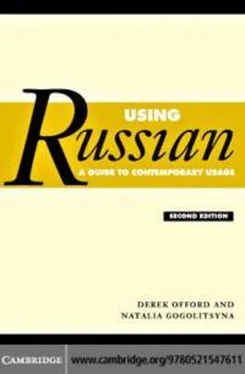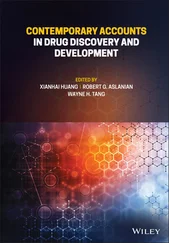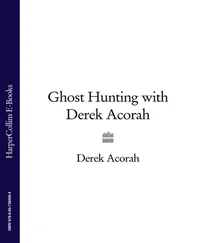Derek Offord - Using Russian - A Guide to Contemporary Usage
Здесь есть возможность читать онлайн «Derek Offord - Using Russian - A Guide to Contemporary Usage» весь текст электронной книги совершенно бесплатно (целиком полную версию без сокращений). В некоторых случаях можно слушать аудио, скачать через торрент в формате fb2 и присутствует краткое содержание. Год выпуска: 2005, Издательство: Cambridge, Жанр: Языкознание, на английском языке. Описание произведения, (предисловие) а так же отзывы посетителей доступны на портале библиотеки ЛибКат.
- Название:Using Russian : A Guide to Contemporary Usage
- Автор:
- Издательство:Cambridge
- Жанр:
- Год:2005
- ISBN:нет данных
- Рейтинг книги:4 / 5. Голосов: 1
-
Избранное:Добавить в избранное
- Отзывы:
-
Ваша оценка:
- 80
- 1
- 2
- 3
- 4
- 5
Using Russian : A Guide to Contemporary Usage: краткое содержание, описание и аннотация
Предлагаем к чтению аннотацию, описание, краткое содержание или предисловие (зависит от того, что написал сам автор книги «Using Russian : A Guide to Contemporary Usage»). Если вы не нашли необходимую информацию о книге — напишите в комментариях, мы постараемся отыскать её.
Using Russian : A Guide to Contemporary Usage — читать онлайн бесплатно полную книгу (весь текст) целиком
Ниже представлен текст книги, разбитый по страницам. Система сохранения места последней прочитанной страницы, позволяет с удобством читать онлайн бесплатно книгу «Using Russian : A Guide to Contemporary Usage», без необходимости каждый раз заново искать на чём Вы остановились. Поставьте закладку, и сможете в любой момент перейти на страницу, на которой закончили чтение.
Интервал:
Закладка:
subst
substantivised
iron
ironical
SW
South-West
lit
literally
tech
technical
loc
locative
theat
theatrical
m
masculine
vulg
vulgar
The Russian particle -нибу´дь is frequently abbreviated to -н.
xxxiii
1 Varieties of language and register
1.1
The Russian language and its distribution
The Russian language belongs to the East Slav group of languages,
itself part of the Slavonic branch of the Indo-European family. The
relationship of Russian to the other modern European languages is
illustrated by Figure 1 (which includes only languages still used by substantial numbers of speakers).
It is difficult to give accurate up-to-date figures for the number of people for whom Russian is their native or first language, or at least their first language for some purpose or purposes (e.g. professional or social). This difficulty arises for several reasons. Firstly, we are dealing with several different categories of user, including the following: ethnic Russians who are citizens of the Russian Federation; ethnic Russians who are citizens of other former republics of the Soviet Union;
members of other ethnic groups who are citizens of the Russian
Federation; and members of other ethnic groups who are citizens of
other former republics of the Soviet Union but who continue to use
Russian at work or at home, perhaps because their community or
family is mainly Russian-speaking. It is not always easy to define
whether Russian is the first or second language of at least the latter two groups. Secondly, there has been much migration between the regions
and states of the former Soviet Union since the collapse of the Union in 1991, with the result that numbers and proportions of ethnic
Russians or other speakers of Russian in each former republic may
have changed significantly over the last thirteen years. Thirdly,
considerable numbers of both ethnic Russians and members of
non-Russian ethnic groups who grew up in Russia or the Soviet
Union using Russian as their first language have in the same period
emigrated from the Russian Federation to countries outside the
former Soviet Union. The number of Jews in the Russian Federation,
for example, fell from roughly 540,000 in 1989 to 230,000 in 2002 and the number of Russian Germans has declined over the same period
from 840,000 to 600,000. It is difficult to determine how many
émigrés continue to use Russian as their first language, or for how
long they do so, after their emigration.
The most easily quantifiable group of Russian-speakers, of course, is the citizenry of the Russian Federation, of which Russian is the official language. According to the census of the Russian Federation carried
out in 2002, the population of the Federation was a little over 145
million, 1 of whom some 116 million (i.e. almost 80 per cent) describe themselves as ethnically Russian.
1
1
Varieties of language and register
Greek
Albanian
Armenian
Russian
Belarusian
(i.e. Belorussian,
White Russian)
Ukrainian
East Slavonic
Other
Slavonic
Serbo-Croat
Slovene
Bulgarian
Macedonian
South Slavonic
Latvian
Lithuanian
Czech
Slovak
Polish
West Slavonic
Baltic
Irish
Welsh
Breton
Celtic
French
Spanish
Portuguese
Italian
Romanian
Romance
languages
Danish
Swedish
Norwegian
Icelandic
North Germanic
opean
Germanic
Indo-Eur
The
1.
English
German
Dutch
Flemish
West Germanic
Fig.
1.1
The Russian language and its distribution
Among the remaining 20 per cent, or approximately 29 million, of
the population of the Russian Federation (many of whom will also
consider Russian their first language) 160 nationalities were
represented, according to the 2002 census. The largest of these
non-Russian groups, in descending order, were Tatars (of whom there
were over five million), Ukrainians (almost three million, although
their number in the Russian Federation has been decreasing), Bashkirs and Chuvashes (over a million each), and Chechens and Armenians
(also over a million each, and their numbers in the Russian Federation have been increasing). Figure 2 shows the composition of the population of the Russian Federation by ethnic group, as revealed by the 2002 census.
Of the non-Russian citizens of the Federation the Ukrainians and
Belorussians (whose numbers in the Russian Federation have also been decreasing) are ethnically close to the Russians. Their languages (i.e.
Ukrainian and Belorussian respectively) are closely related to Russian, which Ukrainians and Belorussians are likely also to speak with native or near-native facility. However, many of the non-Russian citizens of the Russian Federation (e.g. Estonians, Kazakhs, Latvians) belong to quite different ethnic groups from the Russians, including
non-European groups. They may therefore speak a language that is
only distantly related to Russian (e.g. Latvian, which is also
Indo-European) or that belongs to a different linguistic group (e.g.
Estonian, which is a Finno-Ugric language, or Kazakh, which is a
Turkic language). 2 These non-Russian citizens of the Federation have varying degrees of command of Russian. A substantial number of them
consider Russian their first language.
It needs to be borne in mind, incidentally, that different Russian
terms are used to denote the different types of ‘Russian’ who have
been identified in the preceding paragraphs. The substantivised
adjective ру´сский (f ру´сскaя) denotes a person who is ethnically
Russian. Used as an adjective, this word also denotes the Russian
language (ру´сский язы´к). The noun россия´нин (f россия´нкa), on the other hand, conveys the broader concept of a person who is a citizen of the Russian Federation but who is not necessarily ethnically
Russian. The adjective росси´йский has a correspondingly broader
sense than the adjective ру´сский, as, for example, in the name of the country itself (Pосси´йскaя eдeрa´ция), which denotes a political rather than an ethnic, linguistic or cultural entity.
The numbers of ethnic Russian and non-Russian speakers of
Russian outside the Russian Federation are more difficult to quantify.
Some idea of their number can be gauged from the fact that at the
time of the 1989 census (the last census carried out in the Soviet era) there were 25 million ethnic Russians living in other republics of the Soviet Union (see 6.11.1 for a list of these republics), the majority of them in Ukraine. Moreover, since Russian was used as a second
language throughout the non-Russian areas of the Union, whose total
3
1
Varieties of language and register
census
2002
the
to
ding
accor,
roupg
ethnicyb
ederationF
Russian
the
of
opulationP
2.
Fig.
1.1
The Russian language and its distribution
population in 1989 was 287 million, one may assume that the language was used as a first or second language by at least a further 50 million Soviet citizens. However, the status of the Russian language is now
Читать дальшеИнтервал:
Закладка:
Похожие книги на «Using Russian : A Guide to Contemporary Usage»
Представляем Вашему вниманию похожие книги на «Using Russian : A Guide to Contemporary Usage» списком для выбора. Мы отобрали схожую по названию и смыслу литературу в надежде предоставить читателям больше вариантов отыскать новые, интересные, ещё непрочитанные произведения.
Обсуждение, отзывы о книге «Using Russian : A Guide to Contemporary Usage» и просто собственные мнения читателей. Оставьте ваши комментарии, напишите, что Вы думаете о произведении, его смысле или главных героях. Укажите что конкретно понравилось, а что нет, и почему Вы так считаете.












